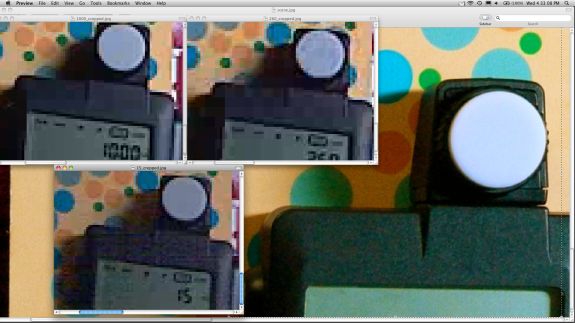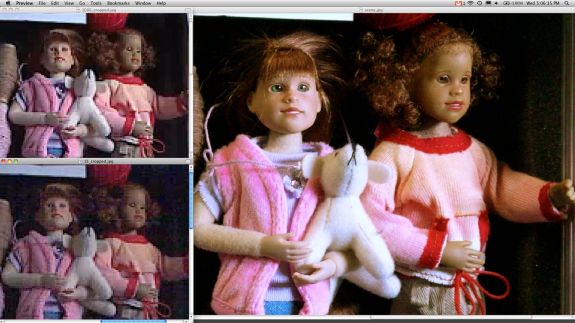Dropcam Echo : Home Security Meets the Cloud
by Ganesh T S on August 11, 2010 7:50 AM EST- Posted in
- Gadgets
- IP cameras
- camera
- camcorder
It has been quite some time since AnandTech reviewed cameras or camcorders for their image and video quality. Even amongst professional gadget review sites, there is an absence of a standardized benchmarking methodology for this purpose. Starting with this review, we have decided to use the Handsome Case for evaluating image and video capture gadgets. This kit can be used to determine and analyze many image and video quality characteristics. However, this section will only deal with factors relevant to a security camera in a home setting.
It is very important for any security camera to have a good performance in low lighting conditions. We performed a quick image quality test of the Dropcam at various light intensity levels. The light temperature was held constant at 5500 K and three light levels were evaluated: 1000 lux, 260 lux, and 15 lux. The evaluation was not extensive and did not included moving objects or resolution measurements. In general, the camera held up well under low light conditions in this static scenario.
One interesting thing is the choice of holding color saturation levels somewhat constant under lower light conditions. Chroma noise becomes prominent at 15 lux, especially noticeable in dark low frequency areas. It is our understanding that most industrial security applications make the design decision to reduce chroma as light intensity falls or simply to move to black and white mode at a given light intensity. The typical security professional would prefer less noise or more color to maintain resolution and detail. Since this is a consumer targeted unit we believe they made the right decision as most consumers likely prefer to see color and will accept the tradeoff of chroma noise. That being said, it might be nice to have a "black and white mode" or some configurability in this area for the discerning low light viewer.
Again, no detailed analysis was performed on the resultant bitstream but the smaller block sizes present in the lower lux scenes seems to indicate that more bits are being used to encode these scenes as the encoder will need to work harder to encode the increased noise patterns.
In Figure 6A, note the low frequency dark area of the color meter. As light intensity is decreased this area contains more noise - especially in the chroma plane. The encoder interprets the noise as detail that needs to be encoded. We don't know the internal workings of the image pipeline, but a 3D noise filter that identifies spatial noise patterns over time would certainly help here. Such filters are present in most of the present day IP camera chipsets. So, future models are likely to have improvements in this area.
In Figure 6B, note the red feather in the scene captured at high lux with a DSLR compared to the screen shots of the unit encoding at 1000 Lux and 15 Lux. The unit loses most of the fine detail at 1000 lux and then works much harder in the lower lux environment likely because a moving noise pattern is present and this noise is attempting to be encoded.
The human eye is trained to look carefully at faces. In Figure 6C, some degradation of the facial resolution is noticeable between 1000 lux and 15 lux, but skin tone is maintained nicely. Note the difference in chroma noise in the low frequency dark area behind each doll.
To summarize the DSP qualities, it can be said that the unit holds up well under differing low light conditions. Chroma levels are maintained with the resultant artifacts noticeable. More configuration options would be nice for low light scenes but the target audience is probably going to be happy with the tradeoffs in the shipped unit.














24 Comments
View All Comments
papounet - Wednesday, August 11, 2010 - link
Very interesting product, yet one caveat:your security system relies on Internet being up; If you go on vacation and switch off the mains, you won't have either current for the cam, nor for Internet.
in europe, several companies are trying to lure small business into setting up IP surveillance cameras, intrusion detection and transmission onto a smartphone (on demand only, in order not to burst the data traffic cap). IP camera like the Axis) have both intrusion detection software onboard and a hardware current loop switch (which could be used for intrusion detector).
the largest issue with video surveillance as i see it: (on my remote screen ;-)) is the lack of support for the megapixel cameras such as the Axis 207MW which have been around for a decent price for some time now.
I highly suspect an artificial restriction by manufacturer of NAS on entry-level systems
I have setup a surveillance DVR 24/7 with a Qnap 219 and 2 * Axis 207MW with few issues except that the QNAP F/W for that hardware does not allow the use of the camera in megapixel res: i am stuck with 15fps 640*480 AVI recording
Yet, using curl, I was able to reach 10 fps at 1280*960 in JPG mode directly from the linux shell.
I am looking seriously into switching to synology because of their more honest way to handle additionnal camera through licenses
strikeback03 - Wednesday, August 11, 2010 - link
Sounds like they have a good start, but I wonder if this model will be sustainable in the future. If a user installed more than one of these, or if/when they produce HD models, the bandwidth usage could quickly get out of hand for tiered access plans. Perhaps for a more extensive home installation they could offer some type of a base station, either a USB device or some type of nettop, that could handle the recording functionality of local cameras. This device could integrate its own access point, so that setting up individual cameras would be as easy as plugging in over USB or ethernet for an initial setup, then putting them on location. They could also then make the mobile app location aware, so that video would only be streamed to their servers when the primary phone was away from home, or on request. Then all other video, such as when they are sleeping and not watching their phone, can be stored locally and not take up bandwidth.rcc - Thursday, August 12, 2010 - link
The camera itself handles motion detection very differently. If set to motion detection the camera doesn't output data at all, until you have a motion event. Sounds like this is one of the features they disablled so they could charge you for continual recording.One of the advantages of IP cameras in general, and one of the things that makes them a bit more expensive that Analog cameras, is that there is a fair amount of intelligence built into the cameras for functions like this.
Axis makes many decent IP cameras, this one is near the bottom of their line, as expected given the price point that people will want.
Since drop cam is not making the camera, I think they should concentrate on the "cloud" end of things, and setup, and let the consumer pick from a range of cameras.
jmke - Wednesday, August 11, 2010 - link
Cut power & internet connection; if possible from a street service panel accessible to anyone with a large cutter.Rick83 - Wednesday, August 11, 2010 - link
And wake everyone who has a UPS in the entire block?Because figuring out which internet connection goes where isn't that easy.
And I expect the same for electricity.
And then you have to hope that there isn't a backup battery and backup wireless internet connection....
Probably not worth the hassle for a quick enter and grab....
Roland00 - Wednesday, August 11, 2010 - link
But since it operates on wifi, and wifi is a very select range of frequencies usually 2.4 ghz or 5 ghz and sometimes 3.6 ghz, wouldn't it be possible to "overload" those bands in a short range with something that produces enough frequency noise.Thus anything that isn't using cables won't be able to communicate. Doesn't matter if the ip cameras are storing there info locally or to the cloud, if you can't talk to the router than the effectively can't communicate.
mados123 - Wednesday, August 11, 2010 - link
This was on one of those CSI episodes where they jammed the signal. WiFi jammers do exists like any other wireless signal blocking.http://www.chinavasion.com/product_info.php/pName/...
rcc - Thursday, August 12, 2010 - link
As I recall, that camera also has an Ethernet port, and works off POE if Dropcam supports it.Hook up the POE switch, router, and modem to a decent UPS and you are ready to go through basic power outages. If you are really concerned about someone cutting your Internet connection, Talk to one of the companies that provides video over 3G cell phone networks. Pretty pricey tho.
strikeback03 - Thursday, August 12, 2010 - link
Would something like this even be valid evidence? Even if you had this camera running and recording an area where something was swiped, assuming the criminal took basic precautions such as covering their face and any other distinguishing marks all you would get from a VGA video is a basic idea of their size. Anything that is going to help bring a criminal to justice is going to come from more traditional investigation.I would imagine the use of this is more as a nannycam, or for example if holes are being dug in your yard and you want to see if it is the neighbor's dog, or a situation like the author described.
rcc - Thursday, August 12, 2010 - link
Look at the bright side. Reviewing the footage (byteage?) would show the forensics guys where to look for more evidence.